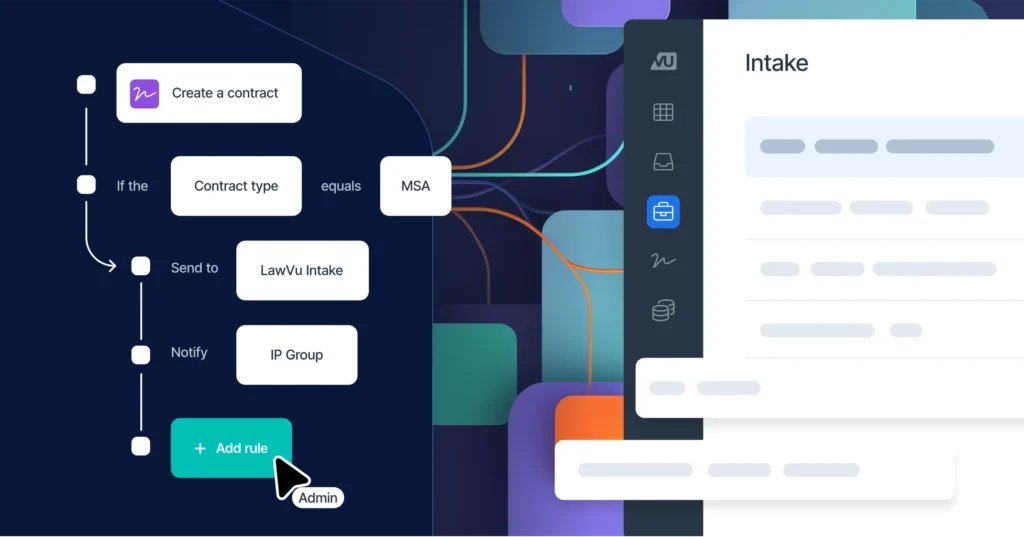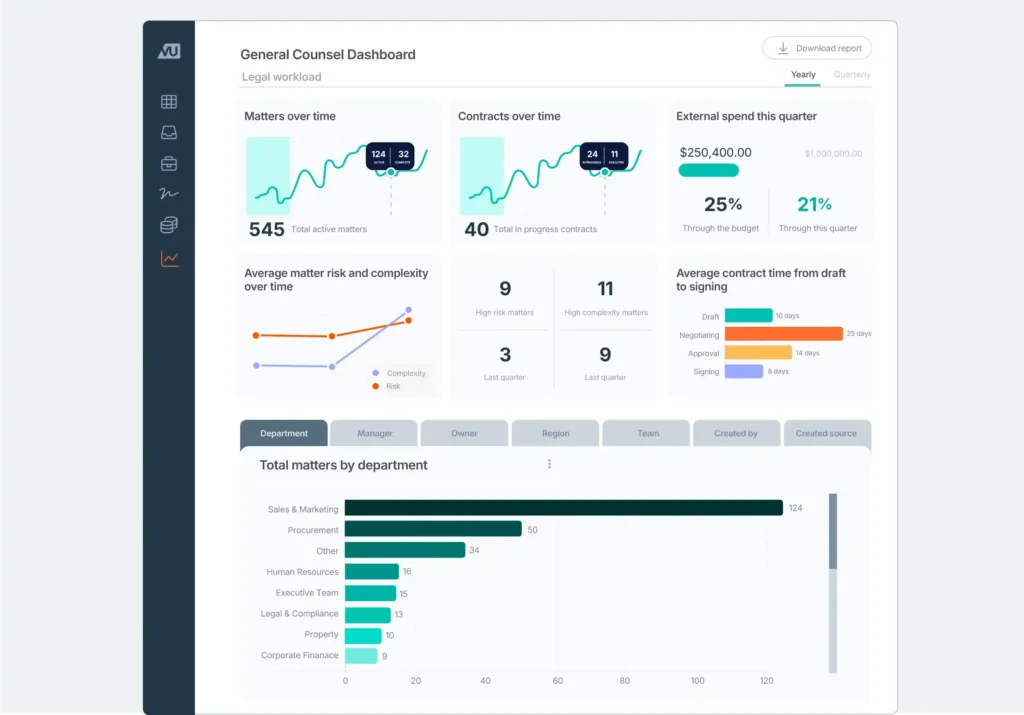Intake and automation recommendations for today’s in-house legal teams

In-house legal teams are facing more pressure than ever. Business leaders want faster responses, seamless collaboration and measurable value from their legal departments – all while being asked to do more with less. The challenge: how can legal operate at speed without compromising quality or burning out the team? The answer lies in modern intake and automation.
In our recent webinar, Intake and automation that really works, LawVu’s Neil Smith (Legal Operations and Transformation Lead) and Mandy Walker (Customer Success Manager), unpacked why modern intake and workflow automation are essential to a successful legal function. Drawing on decades of in-house legal consulting and customer success experience, plus recent IDC research, they walked us through practical strategies legal teams can use to reduce friction, improve business outcomes and elevate their reputation across the organization.
Why streamlined intake and automation matter more than ever
According to IDC’s report, 73 percent of enterprise business leaders believe legal needs improvements in people, process and technology. Even more worrying, 70 percent of business leaders admit they bypass legal altogether when workflows feel too slow. That not only increases risk but also undermines trust between legal and the business.
As Neil put it, “Business outcomes are what it is all about. And a key problem driving those problematic business outcomes is manual intake and daily legal workflows holding the business back.”
When intake feels scattered – whether requests come in by email, instant message, or hallway conversations – legal teams lose valuable time just trying to organize the chaos before they can even begin to work on an actual matter. Business colleagues feel frustrated, perceive legal as a bottleneck, and may even try to work around the team entirely. Structured intake and workflow automation solve this by creating a clear front door into legal and reducing the repetitive, low-value admin that wastes legal’s time.
Where legal friction shows up
Of the surveyed legal teams, 83 percent report that low-value admin takes time away from strategic work and impedes timely service delivery. Legal friction arises when manual, repetitive processes slow down collaboration and output. How many of these challenges are painfully familiar to you?
- Lack of visibility: Scattered requests across emails, conversations, systems and spreadsheets with little insight into team workload, matter statuses or due dates
- Incomplete information: Business users often don’t know what details legal needs to get started
- Prioritization challenges: Every request feels urgent. Due dates and priorities fall through the cracks, and everyone is asking for updates
- Lost time: Hours spent chasing updates, seeking information and re-keying data across systems
How much is your team’s time worth? Mandy shared a common example from one of her clients: “They literally said they reserve every Monday for admin work – an entire day the legal team spends following up on admin. I think that’s crazy for such an expensive resource.”
The takeaway? Without structured intake, legal teams waste their time and talent on low-value work, erode stakeholder confidence and the business pays the price.
Designing intake that the business will embrace
“LawVu offers business stakeholders a single point of access for all their legal needs, knowing they’ll receive the support they need. It also ensures they are directed on the right path and connected to the right people.” – Zach Bates, Legal Operations Manager, The Pokémon Company International
A seamless intake experience equals a great business experience. Legal teams must design intake processes that are simple, scalable and aligned with the way the business works. By understanding your departmental stakeholder’s daily needs and workflows, you can provide the best information and experience to fit their needs and remove any frustration and ambiguity when it comes to requesting advice and support from legal. This means:
- A legal front door: al front door: A single portal where all requests are submitted ensures the business knows what to do and nothing slips through the cracks
- Standardized request forms: By requiring the right fields, legal gets the complete information needed upfront, reducing guess work and back and forth
- Meet the business where they work: Adding integrations with tools like email, Teams or Slack and Salesforce mean business users can initiate requests without switching from the tools they live in
- Self-service: Templates and automated processes for routine contracts like NDAs, MSAs and supplier agreements, plus legal knowledge articles and FAQs, empower the business and reduce bottlenecks for common requests and questions
When creating legal requests is intuitive, consistent and trackable, business users feel confident in the process and legal builds credibility as a responsive, business-focused partner.
The role of automation
Automation builds on structured intake by eliminating the repetitive, low-value tasks that consume so much of legal’s time. Common examples include:
- Self-service: Automating low-risk contracts allows business users to generate agreements instantly, with the option to rout final approvals for higher-risk cases
- Triage and routing: Intake rules that suggest matter owners based on previous patterns and workload to reduce admin and delays
- Workflow tracking: Notifications and dashboards give both legal and the business full visibility into matter statuses, reducing endless “where is this at?” follow-ups
Providing a legal front door and leveraging automation doesn’t remove the personal touch. As Mandy explained, it strengthens it: when the basics run smoothly, in-house lawyers can focus on meaningful conversations and strategic advice rather than routine contracts or chasing information and documents.
Giving a complete picture of legal workload and proving value with data
One of the hidden superpowers of modern intake and automation is the data it generates. When every matter flows through a unified legal workspace, legal teams can:
- Track workloads by risk, complexity and business unit in real-time
- Report on turnaround times and identify bottlenecks
- Demonstrate cost savings from automation
- Spot trends to inform future resourcing or opportunities to automate
- Show the full extent of work legal handles – often invisible without a unified system

As Neil emphasized, data not only improves internal efficiency but also reshapes the perception of legal: from bottleneck to value driver.
Building a stronger legal reputation
Ultimately, intake and automation are not just about efficiency. They are about building stronger relationships with the business and creating more opportunity to focus legal’s effort on more meaningful work. When legal delivers faster, communicates clearly and reduces friction, colleagues notice. Engagement improves, satisfaction rises and legal’s reputation as a trusted partner grows.
As Vera Corbett, General Counsel Newcastle Greater Mutual Group, has shared, their rollout of LawVu was about more than technology: “We used the roadshows to reintroduce legal as a function, showed them how we could align with their strategies, and work proactively to help them succeed.”
That’s the kind of transformation modem intake and automation enables!
Quick recap: Intake and automation playbook for legal teams
- Put yourself in your stakeholders’ shoes: Understand their needs and design intake that works for them
- Build champions: Engage business users and executive sponsors early and empower them to drive adoption of this new way of working with legal
- Embrace self-service: Use templates and FAQs to handle common requests quickly, freeing up legal to focus on high-impact work
- Automate where possible: Start with low-risk, high-volume documents like NDAs, MSAs and supplier agreements, then explore other contract automation possibilities
- Leverage data: Use dashboards and metrics to drive business decisions and showcase legal’s impact
Ready to reduce legal friction in your organization?
Legal teams don’t need to accept intake chaos, workflow inefficiency or a fraught internal reputation. By streamlining intake and embracing automation, they can:
- Deliver faster, higher-quality service to the business
- Free up the team to focus on strategic, high-value work
- Build trust and improve engagement across the organization
- Provide insights and data to improve decision-making and resource planning
- Demonstrate measurable ROI and elevate legal’s role as a true business partner
An intake system that operates within a legal workspace – either with the use of integrations or a portal – has incredible productivity gains and, of course, a powerful single source of truth. At LawVu, we help in-house legal teams make this transformation. And we’d love to show you how.
👉 Book a personalized demo today and see how LawVu’s unified legal workspace can help you eliminate intake chaos, boost efficiency and collaboration, and showcase legal’s full value to the business.
